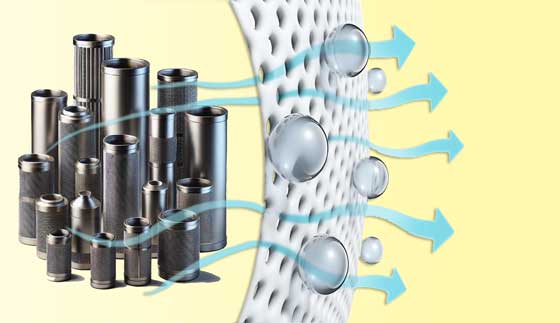Uses of Vapour Permeability Testing for Filtration Systems
 Vapour permeability testing plays a crucial role in filtration systems by ensuring that filters allow the optimal passage of air, gases, or vapours while effectively blocking unwanted particles or moisture. This is essential for maintaining efficiency, longevity, and performance in various filtration applications. Vapour permeability testing plays a crucial role in filtration systems by ensuring that filters allow the optimal passage of air, gases, or vapours while effectively blocking unwanted particles or moisture. This is essential for maintaining efficiency, longevity, and performance in various filtration applications.
Key applications:
- Medical and pharmaceutical filtration
- Tests materials used in sterile environments, such as hospital ventilation systems and pharmaceutical production facilities.
- Ensures medical device filters allow moisture control while preventing bacterial contamination.
- Water and gas filtration membranes
- Evaluates semi-permeable membranes in desalination, wastewater treatment, and gas separation processes.
- Ensures the selective passage of vapour or gases while blocking contaminants.
- Dust collection and industrial pollution control
- Assesses the permeability of filter bags and cartridges in dust collectors to maintain airflow while trapping harmful particles.
- Industrial air filtration
- Evaluates filters used in manufacturing plants, cleanrooms, and chemical processing facilities.
- Helps maintain safe working environments by allowing controlled air exchange while trapping hazardous particles.
- HVAC (Heating, Ventilation, and Air Conditioning) filters
- Ensures air filters allow adequate airflow while capturing dust, allergens, and pollutants.
- Prevents moisture buildup, which can lead to mould growth and reduced air quality.
- Automotive air and cabin filters
- Tests filters in car engines to ensure they allow proper airflow for combustion while trapping dirt and contaminants.
- Ensures passenger cabin air filters balance air permeability with pollutant removal, improving air quality inside vehicles.
- Respiratory protection and PPE (Personal Protective Equipment)
- Used in the development of high-performance face masks and respirators (e.g., N95, FFP3) to balance breathability with filtration efficiency.
- Ensures compliance with health and safety regulations.
- Used in industries such as mining, cement production, and power plants.
- Geotextile and environmental filtration
- Tests fabrics used in soil filtration and water management systems to control moisture movement while allowing necessary permeability.
- Power stations
- Carbon capture and storage (CCS) from power stations is a worldwide high-priority area for technology
 Advantages of vapour permeability testing in filtration systems: Advantages of vapour permeability testing in filtration systems:
- Optimises filter performance by ensuring the right balance between permeability and particle retention.
- Prevents system inefficiencies caused by moisture buildup or excessive airflow restriction.
- Enhances durability by selecting materials that maintain effectiveness over time.
- Ensures regulatory compliance with industry standards for safety and efficiency.
Vapour permeability testing methods & standards for filtration systems
Testing vapour permeability in filtration systems ensures that filters perform optimally, maintaining efficiency and compliance with industry standards. Below are common testing methods and relevant standards.
Common vapour permeability testing methods in filtration systems
- Gravimetric method (ISO 2528, ASTM E96/E96M)
- Measures the mass of moisture passing through a material over time.
- Used in air and gas filtration membranes to assess breathability and moisture control.
- Coulometric sensor method (ISO 15106-3)
- Uses an electrochemical sensor to measure the rate of vapour transmission.
- Common in medical, pharmaceutical, and PPE applications (e.g., respiratory masks).
- Infrared detection (ASTM F1249)
- Uses a modulated infrared sensor to detect water vapour permeability.
- Frequently used in polymer-based filtration materials.
- Dynamic vapour sorption (DVS)
- Measures how materials absorb and release moisture under controlled humidity conditions.
- Applied in cleanroom filtration, industrial dust collectors, and geotextile filters.
- Pressure decay & bubble point tests (ISO 5636, ASTM D726)
- Measures air permeability and resistance to moisture penetration in porous filtration membranes.
- Used for gas separation, breathable fabrics, and industrial air filters.
Key standards for vapour permeability testing in filtration systems
International Standards (ISO & ASTM)
- ISO 11057:2011 – Performance testing of air filters for industrial applications.
- ISO 16890 Series – Classification of air filters based on particulate matter (PM) efficiency.
- ISO 15106 Series – Methods for water vapour transmission rate (WVTR) testing in plastic and coated materials.
- ISO 5636-5 – Measures air permeability of porous filter materials.
- ASTM E96/E96M-22 – Standard for water vapour transmission in sheet materials, widely used in filtration.
- ASTM D737-18 – Measures air permeability in textiles, used for PPE and medical filtration.
European Standards (EN)
- EN 779:2012 (Replaced by ISO 16890) – Particle filtration efficiency for HVAC and industrial filters.
- EN 1822 Series – High-efficiency particulate air (HEPA) and ultra-low penetration air (ULPA) filter testing.
- EN 14683:2019 – Breathability and filtration performance requirements for medical face masks.
UK & industry-specific regulations
- BS EN ISO 5011:2020 – Efficiency testing of automotive and engine air filters.
- BS EN 14683:2019 – UK standard for medical filtration systems and face masks.
- FDA 21 CFR Part 820 – US regulation applicable to UK-based manufacturers exporting medical filtration systems.
- BS EN 143:2021 – Vapour permeability and filtration requirements for respiratory protective devices.
Applications of these testing methods & standards
- HVAC & Industrial Air Filters – ISO 16890, ISO 11057
- Medical & Respiratory Filters – EN 14683, ISO 15106
- Automotive & Engine Filters – BS EN ISO 5011
- Gas & Liquid Filtration Membranes – ISO 5636, ASTM F1249
- Geotextile & Environmental Filters – ASTM D737, ISO 2528
Conclusion
Vapour permeability testing is a fundamental aspect of filtration system development, ensuring that materials strike the right balance between permeability, filtration efficiency, and durability. Across industries—from medical and pharmaceutical applications to industrial air filtration, HVAC systems, and personal protective equipment—these tests help manufacturers design filters that enhance performance while meeting stringent safety and regulatory requirements.
By leveraging advanced testing methods such as mass spectrometry, infrared detection, and pressure decay tests, companies can accurately assess how their filtration materials respond to moisture and air exchange. This not only helps optimize product functionality but also prevents performance degradation due to factors like moisture buildup or excessive airflow resistance.
For manufacturers like Versaperm, investing in precise vapour permeability testing ensures that filtration products maintain high standards of reliability and efficiency. Whether improving air quality in cleanrooms, enhancing respiratory protection, or increasing the lifespan of industrial filtration systems, these tests provide a competitive edge in product development. As filtration technology advances, continued innovation in vapour permeability testing will be key to meeting evolving industry demands, ensuring superior performance and regulatory compliance in an increasingly demanding global market.
| 

 Vapour permeability testing plays a crucial role in filtration systems by ensuring that filters allow the optimal passage of air, gases, or vapours while effectively blocking unwanted particles or moisture. This is essential for maintaining efficiency, longevity, and performance in various filtration applications.
Vapour permeability testing plays a crucial role in filtration systems by ensuring that filters allow the optimal passage of air, gases, or vapours while effectively blocking unwanted particles or moisture. This is essential for maintaining efficiency, longevity, and performance in various filtration applications. Advantages of vapour permeability testing in filtration systems:
Advantages of vapour permeability testing in filtration systems: